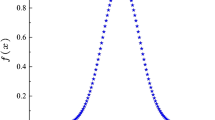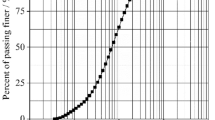Summary
It is well known that deformation and/or strain of geological materials localize when they come close to the failure state. In the present: study, we try to analyze the deformation problem using a constitutive relation with strain hardening and strain softening. The constitutive model of a soft rock and overconsolidated clay using an elasto-plastic constitutive theory with memory was originally developed by Adachi and Oka. This type of formulation is shown to be easily applied to analyze the material behavior of strain softening because there is a similarity to that in viscoplasticity. Using the proposed model, the loss of uniqueness of the solution to the initial value problem can be avoided and a special or complicated numerical technique, e.g., an arc length method, does not need to be used. When we use constitutive equations with strain softening in a finite element analysis, there is a problem of strong mesh size dependency of numerical results. To remedy the mesh size dependency, we generalize the Adachi-Oka model based on the concept of non-localization by Bazant. We apply the proposed constitutive model to the behavior of a sedimentary soft rock in the drained triaxial compression test. It is found that mesh size dependency becomes smaller using the non-localization of the constitutive model.
Übersicht
Bekanntlich findet bei geologischen Stoffen in der Nähe des Versagenszustandes eine Lokalisierung der Verformung statt. Die Analyse dieses Problems wird in diesem Beitrag auf der Grundlage eines Stoffansatzes mit Ver- und Entfestigung unternommen. Entwickelt wurde das zugrunde gelegte elastischplastische Stoffmodell mit Gedächtnis von Adachi und Oka für weiches Gestein und übermäßig verdichteten Ton. Wegen der Ähnlichkeit zur Viskoplastizität läßt sich diese Formulierung des Stoffgesetzes leicht auf die Analyse des Verhaltens von entfestigendem Material anwenden, da der Eindeutigkeitsverlust der Lösung des Anfangswertproblems vermieden wird und besondere Rechenverfahren wie etwa die Bogenlängenmethode nicht benötigt werden. Bei der Benutzung von Stoffgesetzen in einer Finite-Element-Rechnung hängen die Ergebnisse stark von der Netzeinteilung ab. Um dies abzustellen, wird das Modell von Adachi und Oka auf der Grundlage von Bazant's Konzept der Nichtlokalisierung verallgemeinert. Anwendungsbeispiel ist das Verhalten von weichem Gestein im drainierten Triaxial-Test. Es zeigt sich, daß mit dem Konzept der Nichtlokalisierung im Stoffmodell der Einfluß der Netzeinteilung geringer wird.
Similar content being viewed by others
References
Cundall, P. A.: Numerical experiments on localization in frictional materials. Ing. Arch. 59 (1989) 148–150
Riks, E.: The application of Newton's method to the problem of elastic stability. J. Applied Mechanics. 39 (1972) 1060–1066
Wempner, G. A.: Discrete approximations related to nonlinear theories of Solid. Int. J. Solids Struct. 7 (1971) 1581–1599
Oka, F.; Adachi, T.: An elasto-plastic constitutive equation of geologic materials with memory. Proc. 5th Int. Conf. Num. Meth. in Geo. Nagoya. Balkema. (1985) 293–300
Valanis, K. C.: A theory of viscoplasticity without a yield surface, Part I. Arch. of Mech. 23 No. 4 (1971) 517–533
Valanis, K. C.: On the uniqueness of solution, of the initial value problem in softening materials. J. Applied Mechanics. 52 (1985) 649–653
Akai, K.; Adachi, T.; Nishi, K.: Mechanical properties of soft rocks. Proc. 9th Int. Conf. Soil Mech. Found. Eng. Tokyo. Balkema. Vol. 1 (1977) 7–10
Nayak, G. C.; Zienkiewicz, O. C.: Elasto-plastic stress analysis. A generalization for various constitutive relations including strain softening. Int. J. Numerical Methods in Engineering. 5 (1972) 113–135
Prevost, J. H.; Hoeg, K.: Soil mechanics, and plasticity analysis of strain softening. Geotechnique. 25 No. 2 (1975) 279–297
Bannerjee, P. K.; Stipho, A. S.: An elasto-plastic model for undrained behavior of heavily over-consolidated clays, short communication. Int. J. Numerical, and Analytical Methods in Geomechanics. 3 (1979) 97–103
Read, H. E.; Hegemier, G. P.: Strain-softening of rock, soil and concrete—a review article. Mech. Mat. 3 No. 4 (1984) 271–294
Sandler, I. S.: Strain-softening for static and dynamic problems. Proc. Symp. on Constitutive Equations: Marco and Computational Aspects ASME. Winter Annual Meeting. New Orleans. Ed. by William, K. J. ASME (1986) 217–231
Truesdell, C.; Noll, W.: Non-linear field theories of mechanics. Ed. by Flugge. III/3. Springer (1965) 36–48
Bazant, Z. P.: Nonlocal continuum damage, localization instability and convergence. J. Appl. Mech. ASME 55 (1988) 287–293
Bazant, Z. P.; Belytschko, T. B.: Strain.-softening continuum damage: localization and size effect. In: Desai, C. S. et al. Proc. Int. Conf. on Constitutive Laws for Engineering Materials. Vol. 1. pp. 11–33. Tucson: Elsevier 1987
Bazant, Z. P.; Lin, F. B.; Pijaudier-Cabot, G.: Yield limit degradation: nonlocal continuum with local strain. In: Onate, E. et al., Proc. Int. Conf. on Computational Plasticity, pp. 1757–1779. Barcelona: University of Swansea 1987
Stricklin, J. A.; Haisler, W. E. and Von Riesemann, W. A.: Evaluation of solution procedure for materia and/or geometrically nonlinear structural analysis. AIAA Journal. Vol. 11 No. 3 (1973) 292–299
Frantziskonis, G.; Desai, C. S.: Constitutive model with strain softening. Int. J. Solid and Structures. Vol. 23 No. 6 (1987) 733–750
Frantziskonis, G.; Desai, C. S.: Analysis of a strain softening constitutive model. Int. J. Solid and Structures. Vol. 23 No. 6 (1987) 751–767
Takayasu, H.: A deterministic model of fracture. Prog. Theor. Phys. Vol. 74, No. 6 (1985) 1343–1345
Author information
Authors and Affiliations
Rights and permissions
About this article
Cite this article
Adachi, T., Oka, K.F. & Gifu, A.Y. A finite element analysis of strain localization for soft rock using a constitutive equation with strain softening. Arch. Appl. Mech. 61, 183–191 (1991). https://doi.org/10.1007/BF00788052
Received:
Issue Date:
DOI: https://doi.org/10.1007/BF00788052




